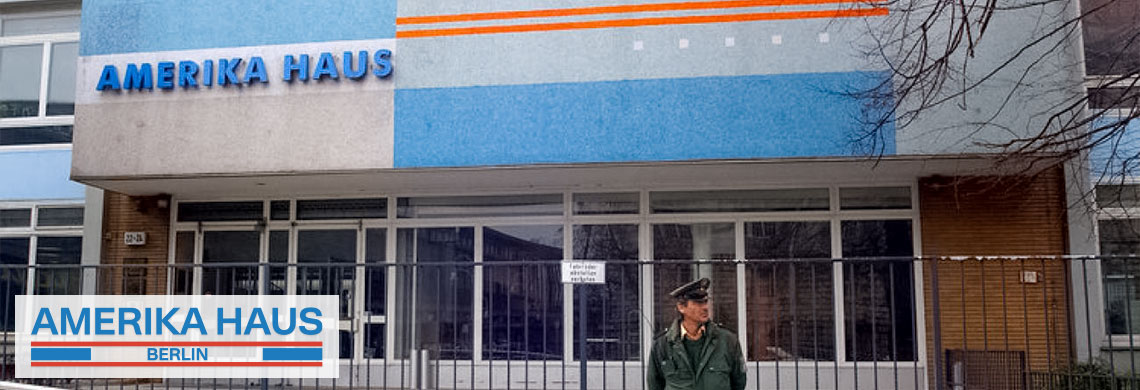A Young American Journalist Working in the Historic Amerika Haus: by Jeremy Faulkner
As the Amerika Haus’ most current American occupant I join a long and impressive list of Americans who also once occupied this building since its establishment in 1957. Although the Haus itself was built long before I was born, its utility as a work, performance and meeting space is unchanged. In my view, the Haus’ character remains fixed because of what the Haus has always stood for: a center dedicated to promoting the ideals of democracy. These ideals served as the architectural blueprint for the Amerika Haus, and are what robustly sustain it today.
Its roof provided shelter from the storm of the Cold War. At a time when propaganda, backed by nuclear threat, was dividing the world into East and West, the Amerika Haus allowed for its patrons to seek clarity by offering them current and objective material: a vast collection of writings, international press, and a platform for anyone to openly discuss politics. Anchored deep in former West Berlin, the Haus was and is a reflection of a society’s ability to flourish where citizens are allowed to question and criticize their governments openly.
Not just citizens, but those in the field of journalism as well. I must give particular mention to those generations of American journalists before me who were fleetingly or permanently based in the Haus. What the Haus offered them in its vast collection of precious writings and high level visitors was priceless. Like me, generations of journalists used the Haus to dispatch messages, conduct research and attend public forums.
Yet for as much as the Haus did provide, it was equally viewed as menacing, propagandist and unwelcoming, particularly by Moscow. Nor was the Haus by its own virtue an instrument of peace. The Haus’ establishment and role as a facilitator of non-violent cultural diplomacy coincided with one of the largest nuclear arms race in history.
The same year the Haus’ first layers of foundation were laid in Berlin, the Soviet-engineered Sputnik satellite was launched to the heavens, like a foreboding shooting star. 1957 was a year of great displays of power between the United States and the Soviet Union. Yet what America began with its simple construction of the Haus that year in occupied West Berlin was a display of power which proved to outlast even the most sophisticated technological prowess. That is, the Haus facilitated non-violent movements and services at a time when the world was tinkering with the machinery of death.
In this endeavor, the Haus has taken many forms. In addition to serving as a library, a performance venue, and a work space, it has also been used by the United States government to house US sponsored student cultural exchange programs. At one point the Haus housed the office space for a student exchange program called the ‘Congress-Bundestag Youth Exchange’, a twenty-five year old program which allows for a full-year exchange between German and American students, and of which I myself am a direct beneficiary.
Yet despite the Haus’ historical role as a facilitator of Western values and American culture, it remains haunted by rumors that in reality it served as the work space for American spies and intelligence agencies, the workers of America’s “hard power”. Unsubstantiated as such rumors are, they contribute to a narrative that has defined the Haus’ sentimental role for Berliners for the last fifty years.
That sentimental aura that the Haus invokes in people is what has kept it alive today, twenty years after the end of the Cold War. Over the last fifteen years American politicians have condemned the Haus as basically obsolete. Absolvent of responsibilities, the United States politely handed over the Haus’ keys to the Berlin city government in 2006. Since then, the humble Haus has had to dodge threats of becoming a McDonald’s, and even complete demolition.
But because of the activism of non-governmental organizations such as the Institute for Cultural Diplomacy and other citizens groups, the Amerika Haus still retains its seat on Hardenbergstrasse. And far from being an out-dated relic of the past, the Haus—now like an elderly and distinguished statesman—continues to be abuzz with activity. Its historical novelty as a site of American ideals in the Cold War landscape re-affirms a sense of nostalgia for many.
It continues to be frequently used by many other people as well. In addition to your correspondent, its regular occupants and visitors include an American musician using the Haus for rehearsal space and a host of workers organizing cultural exchange programs. It continues to serve as a venue for public lectures, readings and political gatherings. This week alone the Haus will host a member of the German parliament, a representative from the Russian Embassy, a European Parliament member, and a host of academics and artists.
For those journalists who occupied this building before me, I must give special homage to as matter of professionalism and nationhood. It must have been interesting—maybe even romantic—to occupy this site when it was the anchor of former West Berlin; and when pen-to-paper writing carried the day. Like me, I can only assume I share the same reasons for coming to the Amerika Haus as that generation had: to learn and to explore.











